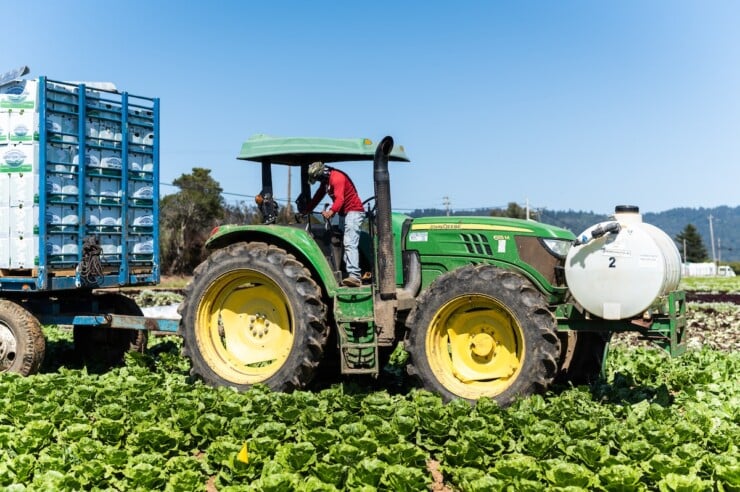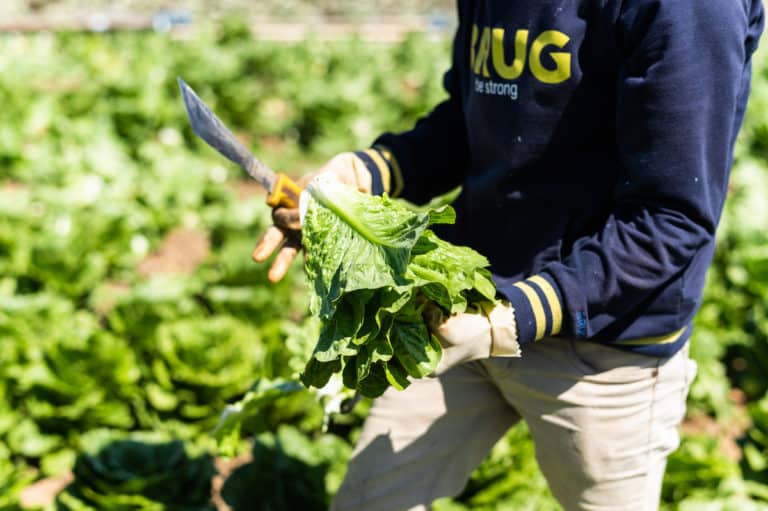“Wait, what is grown in California?” As soon as we mention that we’re all about food and we’re based in California, this is the question we get from our travel clients. You see, the Golden State has a reputation for being a major agricultural player, but its significance is often not fully understood.

Key Takeaways
- Major Food Producer: California grows over 400 commodities and produces nearly half of all U.S.-grown fruits, vegetables, and nuts—thanks to its Mediterranean climate and diverse geography.
- Key Crops: The state leads the nation in crops like almonds, avocados, grapes, tomatoes, strawberries, lettuce, citrus, and rice—plus specialty crops like figs, dates, artichokes, and olives.
- Regional Variety: From Central Valley orchards to coastal strawberry fields, different regions contribute distinct crops based on microclimates and soil.
Perhaps you’ve tried some local artisanal cheeses, savored iconic California foods, visited world-class California wine regions, or shopped for everything from avocados to zucchini and even flowers, all labeled ‘California Grown.’ But it can be hard to fathom exactly what that means.

What Percentage Of Agriculture Does California Produce?
When people hear that California is the largest agricultural producer in the nation, they immediately want to know, “But exactly how much?”
According to the California Department of Food and Agriculture (CDFA), over a third of the country’s vegetables and two-thirds of the country’s fruits and nuts are grown in California. Additionally, the Golden State leads the national production of over 60 crops, including almonds, artichokes, dates, olives, clingstone peaches, prunes, and walnuts.

Sustainable Agriculture In California
In California, sustainability in agricultural production has long been a significant topic of discussion. Across the state, farms and ranches are working to make their farm operations increasingly sustainable through initiatives such as zero-waste efforts, water reduction actions, fair and equitable labor practices, and other regenerative agricultural practices. Although it’s a work in progress, California already leads the nation in sustainable dairy production and the world in sustainable wine production.

Where are the major agricultural regions of California?
The truth is that produce is grown almost across the whole state – the only parts of California that don’t grow something are either too hot or too high in altitude. However, among the many regions with agriculture, the largest are the San Joaquin Valley, the Salinas Valley in Monterey, and the Imperial Valley.
And, proof that the San Joaquin takes the agricultural cake, more than 250 of the 400 crops grown in California are grown in the San Joaquin Valley. Of course, certain areas are best known for growing certain crops, such as avocados and citrus in Southern California, lettuce in Monterey and Imperial counties, and wine in regions like Napa Valley or Lodi.

Wine Producing Regions In California
Speaking of what is grown in California, the world’s best-known agricultural product is undoubtedly world-class wine. It’s so popular that parts of California are dominated by wine production, including Santa Ynez Valley, Paso Robles, Sonoma County, Monterey, Lodi, and Mendocino.
There are more than 130 American Viticultural Areas (AVAs) across the state. Head here to learn which California wine regions you should travel to on your next trip to California.

What Is Grown In California?
Okay, now for the question you came for: what is grown in California? The answer is a LOT, and the state’s Mediterranean climate is to thank! California produces over 400 crops; here is a look at the produce the Golden State is best known for:
- Almonds: California produces approximately 80% of the world’s almonds, and almond growers continually innovate ways to make their production more efficient, reduce water consumption, and adopt zero-waste initiatives.
- Artichokes: Nearly 100% of all artichokes commercially available in the United States are sourced from California, with the majority originating from Monterey County.
- Avocados: California is the largest producer of avocados in the U.S. Many are grown in the coastal regions between San Diego and Monterey. Seven avocados are commercially grown in California, but the Hass variety is the most popular, accounting for approximately 95% of the total crop volume.
- Citrus: Yes, you think of Florida for oranges, but California produces 80% of all the fresh citrus in the United States. Across the state, you’ll see citrus as varied as Meyer lemons, Kishu Mandarins, and Cara Cara oranges.
- Dairy: California Dairy ranks first out of the fifty states in dairy production, with more than 1,100 dairy farms, 99% of which are family-owned.
- Dates: Over 90% of U.S. production is grown in California, specifically in the Coachella Valley.
- Garlic: California produces 90% of the nation’s garlic, with more than half of that coming from Christopher Ranch, based in Gilroy.
- Grapes: To be clear, there are two main categories of grapes in California: table grapes (the ones we eat) and wine grapes. Over 80 varieties of California table grapes are available from May through January.
- Leaf Lettuce: The majority of lettuce and leafy greens consumed in the United States are grown in California, which produces approximately 70% of the volume. It’s always lettuce season in California: the alternating climates in Southern & Northern California allow leafy greens to be grown year-round.
- Olives: California Ripe Olives, sold canned or jarred, are grown on family farms in the inland valleys of California from San Diego County to the north of Sacramento.
- Pistachios: More than 98% of pistachios produced in the U.S. are grown in California and predominantly grown in the southern San Joaquin Valley.
- Strawberries: Strawberries grow along the California coast on about 35,000 acres. During peak season, strawberries are harvested in Salinas, Watsonville, Santa Maria, Oxnard, and Orange County. During the cooler months, strawberries remain harvested in Santa Maria and Oxnard, making California strawberries available year-round.
- Prunes: California grows 99% of the U.S. production of prunes and 40% of the worldwide production! We like to use the D’Noir Prunes in recipes because they’re preservative-free, and they tend to be plump and flavorful.
- Walnuts: California walnuts account for nearly all the walnuts grown in the United States.

Recipes Using California Produce
Got your hands on some local California produce? Lucky you! Here are 21 recipes to make:
- Avocado Coconut Strawberry Semifreddo
- Blood Orange Olive Oil Polenta Cake
- Easy California Date Shake
- California-Style Crunchy Fried Avocado Taco
- California Greek Olive Salad
- Chocolate-Covered Prune And Almond Clusters
- Chai-Infused Prune Easy Clafoutis Recipe
- Crunchy Fried Avocado Tacos
- Crunchy Romaine Salad Recipe With Maple Soy Vinaigrette
- Easy Homemade Chocolate Bark
- Gluten Free Easy Green Olive Pasta Salad Recipe
- Grilled Artichoke Recipe With Herbed Roasted Garlic Aioli
- Honey and Oregano Broiled Feta Caprese
- Kumquat Pistachio Brown Butter Tea Cakes
- Prune and Apple Tart
- Citrus Walnut Quinoa Feta Salad
- Salted Almond Healthy Brownie Recipe
- Smashed Green Olive And Pistachio Burrata Bruschetta
- Spiced Grape Granita Parfait
- The Best Roasted Garlic Oil Recipe
Get A Personalized Travel Itinerary

Towns Along California Highway 1 To Visit
Visiting California soon? You’ll want to read our picks of towns along California Highway 1 to visit from Cambria to Carmel and Montecito to Monterey.

California Road Trip Travel Guide
Thinking about taking a road trip in the Golden State? You’ll want to check out our California Road Trip Travel Guide for travel tips, itinerary ideas, and more California-inspired recipes.
Have Us Plan Your California Trip
Did you know we’re also a boutique travel agency specializing in California vacation planning? If you’re planning a trip to California, our California trip planner services can help you create your perfect itinerary.
Photo Credit: Dairy cow and farmer photo by Alycia Moreno; Granita photo by Salt & Wind Travel; all other photos by James Collier.